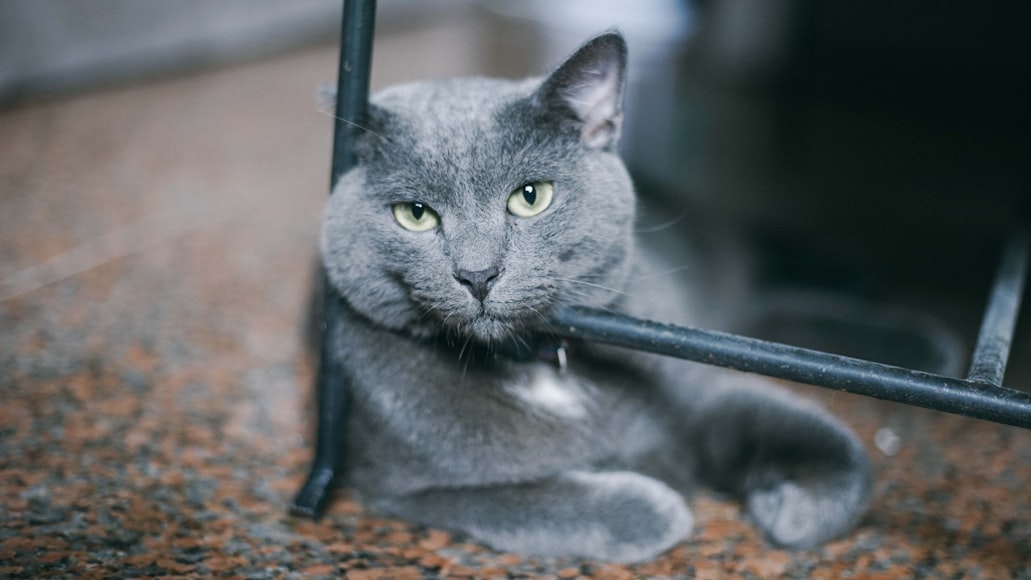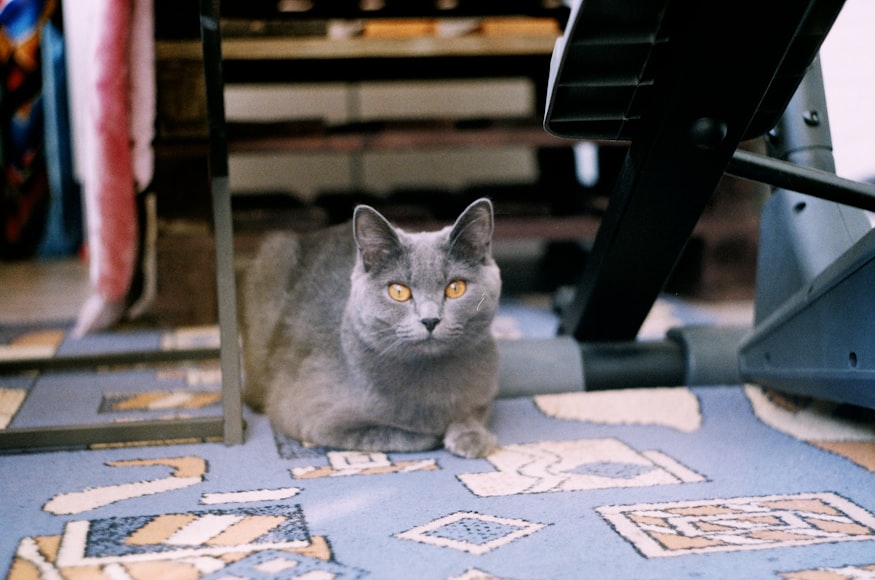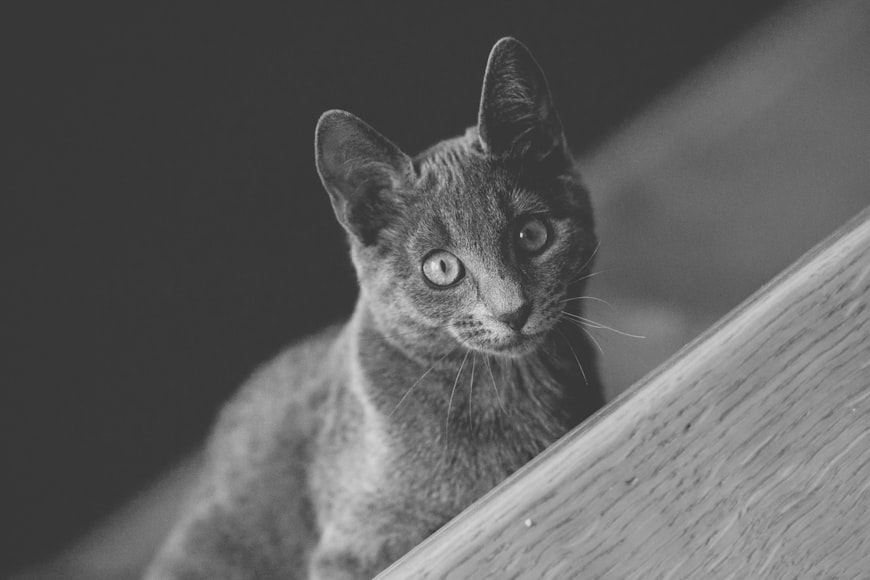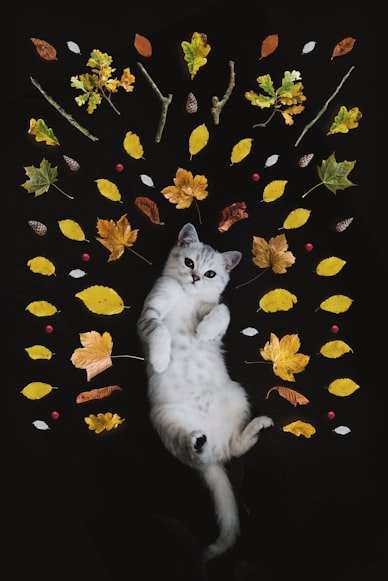Russian Blue Cat: A Comprehensive Guide

Introduction:
The Russian Blue Cat is a captivating and enigmatic feline breed that has captured the hearts of cat enthusiasts worldwide. Known for its striking blue-gray coat, piercing green eyes, and gentle demeanor, this breed has become a popular choice for pet owners seeking a loyal and loving companion.
History:
The exact origins of the Russian Blue Cat remain somewhat shrouded in mystery. It is believed that the breed originated in the Arkhangelsk region of Russia during the 1600s. Sailors transported these cats to England in the 1860s, where they gained recognition as the Archangel Cat and later, the Russian Blue.
Physical Characteristics:
- Coat: The Russian Blue Cat’s most distinctive feature is its double-layered, blue-gray coat. The guard hairs are a medium length and have a silvery sheen, while the undercoat is dense and soft. The coat is short and plush, giving the cat a velvety appearance.
- Eyes: The Russian Blue’s eyes are a mesmerizing shade of emerald green. They are large and almond-shaped, giving the cat an intelligent and expressive look.
- Body: The Russian Blue is a medium-sized cat with a muscular and well-balanced body. They have a long, tapering tail and a rounded head with a slightly upturned nose.
- Size: Male Russian Blues typically weigh between 8 and 12 pounds, while females weigh between 6 and 10 pounds. They reach maturity at around 2 to 3 years of age.
Personality and Temperament:
The Russian Blue Cat is known for its gentle and affectionate nature. They are highly intelligent and eager to please their human companions. Here are some key personality traits:
- Loyal: Russian Blues form strong bonds with their owners and are known for their unwavering loyalty.
- Playful: Despite their laid-back demeanor, Russian Blues can be playful and active, particularly when they’re young.
- Talkative: Contrary to the stereotype of quiet cats, Russian Blues are known for their soft and gentle meows.
- Independent: While they enjoy affection, Russian Blues are also comfortable being left alone for short periods.
- Grooming: Russian Blues are meticulous groomers and take pride in keeping their coats clean and tidy. They may not require frequent bathing.
Health and Care:
With proper care, Russian Blue Cats typically live for 12 to 15 years. Here are some health considerations and care tips:
- Diet: Provide a high-quality diet rich in protein and omega-3 fatty acids.
- Dental Care: Brush your cat’s teeth regularly to prevent dental disease.
- Nail Trimming: Trim your cat’s nails as needed to keep them from becoming overgrown.
- Exercise: Provide ample exercise and mental stimulation through toys, scratching posts, and interactive play.
- Vaccinations: Keep your cat up-to-date on vaccinations to protect against common diseases.
Conclusion:
The Russian Blue Cat is a remarkable breed that offers a delightful combination of beauty, intelligence, and affection. With their gentle personalities and striking appearance, these cats make exceptional companions for individuals and families alike. By understanding and providing them with the proper care, you can enjoy many years of love and companionship from your beloved Russian Blue.
Appearance

As a Russian Blue Cat pet blogger, I’m frequently asked about the unique characteristics and striking appearance of our beloved felines. Here’s a comprehensive guide to the physical attributes that make Russian Blue Cats such alluring companions:
Physical Characteristics
- Size: Russian Blue Cats are typically medium-sized, with males weighing around 8-12 pounds and females weighing around 6-9 pounds.
- Weight: As mentioned earlier, males tend to be heavier than females, but overall, Russian Blues have a lean and muscular build.
- Body Type: The breed has a semi-cobby body type, with a muscular chest and a slightly arched back. They possess a gentle curve from their shoulders to their tail, giving them a graceful silhouette.
- Coat: Russian Blue Cats are known for their plush, double-layered coat that gives them a velvety appearance. The outer coat is short to medium in length, measuring around 1-2 inches. The undercoat is dense and woolly, providing excellent insulation.
Fur
- Color: The Russian Blue’s coat is a distinctive shade of blue-gray, known as “Russian Blue.” The blue hue is not uniform throughout, as it is darker at the base and lighter at the tips, creating a subtle shimmer.
- Texture: The fur of Russian Blue Cats is soft and silky to the touch. It has a resilient texture, bouncing back to its original shape after being stroked.
- Length: As mentioned previously, the outer coat of Russian Blues is short to medium in length, giving them a sleek and refined appearance.
Eye Color
- Color: Russian Blue Cats have stunning emerald-green eyes that are large, expressive, and set wide apart. This eye color is a striking feature that adds to the breed’s allure.
Distinctive Features
- Rounded Head: Russian Blues have a rounded head with well-defined cheekbones and a prominent forehead.
- Prominent Ears: Their ears are large, slightly pointed, and set high on the head. They give the breed an alert and inquisitive expression.
- Almond-Shaped Eyes: In addition to their green color, the eyes of Russian Blue Cats are almond-shaped, further enhancing their elegant appearance.
- Slender Tail: The tail of a Russian Blue Cat is long and slender, tapering to a fine point. It is often carried low and can occasionally be curved over the back.
These physical attributes combine to create a captivating and distinctive appearance that sets Russian Blue Cats apart from other breeds. Their plush coat, shimmering blue-gray color, and piercing green eyes make them a truly enchanting sight.
Temperament

As an esteemed Russian Blue Cat pet blogger, I am thrilled to delve into the extraordinary temperament that sets this breed apart. From their distinct personalities to their remarkable social skills, the Russian Blue Cat is a true treasure in the feline world.
Personality Traits
Russian Blue Cats possess a unique blend of personality traits that make them both enchanting and endearing. Their calm and collected demeanor sets them apart as feline companions who exude serenity. They are known for their affectionate nature, often seeking out cuddles and lap time with their beloved humans.
Moreover, their intelligence shines through in their inquisitive nature and trainability. Russian Blue Cats are highly observant and enjoy engaging in interactive games and puzzles. Their sharp minds make them quick learners, eager to please and eager to explore their surroundings.
Socialization and Behavior
Russian Blue Cats are inherently social creatures who thrive in the company of humans. They build strong bonds with their family members and enjoy interacting with visitors. With proper socialization, they can also become comfortable around children and other pets.
However, it’s important to note that Russian Blue Cats can be sensitive to loud noises and sudden movements. Providing a calm and predictable environment is crucial for their well-being. They appreciate a consistent routine and may become anxious if their lifestyle is disrupted.
Compatibility with Children and Other Pets
Russian Blue Cats are generally good with children who are respectful and gentle. Their calm demeanor and affectionate nature make them a potential match for families with older children who understand how to interact with cats.
With proper introductions and supervision, Russian Blue Cats can coexist harmoniously with other pets, such as dogs. However, it’s important to ensure that each animal has its own space and resources to avoid potential conflicts.
Conclusion
The Russian Blue Cat is a captivating breed with a temperament that strikes a balance between affectionate, intelligent, and social. Their calm nature and trainability make them perfect companions for people seeking a low-maintenance yet engaging feline friend. With proper socialization and care, Russian Blue Cats can thrive in a loving and fulfilling environment, bringing endless joy and companionship to their human families.
Health

Introduction:
The Russian Blue cat is a beloved breed known for its distinctive blue-gray coat, emerald eyes, and affectionate nature. While generally healthy, this breed is prone to certain health conditions that pet owners need to be aware of.
Common Health Issues and Diseases:
1. Hyperthyroidism:
A common condition in Russian Blues, hyperthyroidism occurs when the thyroid gland overproduces hormones. Symptoms include weight loss, increased appetite, thirst, and urination.
2. Feline Lower Urinary Tract Disease (FLUTD):
FLUTD encompasses a range of conditions affecting the lower urinary tract, including cystitis and urethritis. Symptoms include frequent urination, straining to urinate, and bloody urine.
3. Dental Disease:
Russian Blues can be prone to dental issues such as gingivitis and periodontitis. Regular dental check-ups and cleaning are crucial to prevent these problems.
4. Polycystic Kidney Disease (PKD):
A genetic condition, PKD affects the kidneys and can lead to kidney failure. Early detection through genetic testing is recommended.
Life Expectancy:
Russian Blue cats typically have a life expectancy of 10-15 years. With proper care and nutrition, some individuals may live even longer.
Dietary Considerations and Nutritional Needs:
To maintain optimal health, Russian Blue cats require a diet that meets their specific nutritional needs:
1. Protein:
Russian Blues are carnivores and require a high-protein diet. Look for cat food formulas that contain a minimum of 30% protein from quality sources such as chicken, fish, or lamb.
2. Taurine:
Taurine is an essential amino acid for cats that plays a crucial role in heart and eye health. Ensure the cat food contains adequate levels of taurine.
3. Fats:
Healthy fats contribute to a shiny coat and overall well-being. Opt for cat food that contains essential fatty acids, such as omega-3 and omega-6.
4. Carbohydrates:
While not essential, some carbohydrates can provide energy. Look for cat food with moderate levels of digestible carbohydrates, such as brown rice or sweet potato.
5. Hydration:
Fresh, clean water is vital for preventing urinary tract infections. Encourage your cat to drink plenty of water and consider adding a water fountain to its routine.
Conclusion:
By understanding the common health issues and diseases that affect Russian Blue cats and providing them with a balanced diet, pet owners can help their feline companions lead long and healthy lives. Regular veterinary check-ups, dental care, and a nutritious diet are key to maintaining the well-being of these beloved companions.
Grooming

As a devoted Russian Blue cat parent, maintaining your feline companion’s impeccable appearance and overall well-being requires meticulous grooming. Here’s a comprehensive guide to ensure your Russian Blue shines with grace and elegance:
Coat Care
Brushing:
- The Russian Blue’s double-layered coat requires regular brushing to prevent matting and promote a shiny, healthy appearance.
- Brush your cat weekly with a slicker brush to remove loose hair and distribute natural oils throughout the coat.
- During shedding season (spring and fall), increase brushing frequency to two to three times per week.
Bathing:
- Russian Blue cats have short, dense coats that do not require frequent bathing.
- Bathe your cat only when necessary, such as if it has gotten into something particularly messy. Use a cat-specific shampoo and warm water.
Shedding:
- Russian Blue cats shed moderately twice a year.
- During these periods, daily brushing and extra vacuuming are essential to keep your home fur-free.
Dental Hygiene
- Good dental hygiene is crucial for your cat’s overall health and well-being.
- Brush your cat’s teeth several times a week with a pet-approved toothpaste.
- Provide dental treats and chews to encourage good oral habits.
- Consider regular dental checkups with your veterinarian.
Other Grooming Needs
Nails:
- Trim your cat’s nails regularly to prevent scratching, overgrowth, and discomfort.
- Use a sharp, cat-specific nail clipper and trim only the white tip of the nail.
Ears:
- Inspect your cat’s ears weekly for signs of infection or mites.
- If necessary, gently wipe the ears with a cotton ball dampened with warm water.
- Avoid using cotton swabs, which can damage the delicate ear canal.
Conclusion
Regular grooming is an essential part of caring for your Russian Blue cat. By following these grooming tips, you can maintain your feline companion’s elegant appearance, improve its overall health, and strengthen your bond. Remember, your cat’s well-being and happiness depend on your unwavering dedication to its grooming needs.
Feeding
As a dignified and discerning feline, the Russian Blue cat requires a balanced and nutritious diet to maintain its regal appearance and impeccable health. This article will provide you with all the essential information you need to feed your beloved companion optimally.
Dietary Requirements
The nutritional needs of Russian Blue cats vary depending on their age and activity level.
Kittens: Rapidly growing kittens require a diet high in protein, fat, calcium, and other essential nutrients. Kitten-specific food formulas are designed to meet their unique requirements.
Adult Cats: Adult Russian Blue cats need a diet moderate in protein, high in moisture, and low in carbohydrates. This helps maintain a healthy weight and prevent common feline health issues such as urinary tract infections.
Recommended Food Types and Brands
Choosing the right food for your Russian Blue is crucial. Here are some highly recommended food types and brands:
- Wet Food: Wet food provides ample moisture, which is essential for urinary tract health. Look for formulas with high-quality protein sources and limited carbohydrates. Consider brands such as Blue Buffalo Wilderness and Hill’s Science Diet.
- Dry Food: Dry food is convenient for cats who prefer to graze throughout the day. Opt for formulas with a moderate protein content (25-35%) and a low carbohydrate content (less than 10%). Purina Pro Plan and Iams Proactive Health are reputable dry food brands.
- Raw Food: Raw food mimics a cat’s natural diet and is rich in essential nutrients. However, it requires careful preparation and handling to ensure safety. Consult with your veterinarian before transitioning to a raw food diet.
Feeding Frequency and Portion Sizes
The frequency and size of meals depend on your cat’s age, weight, and health status.
Kittens: Feed kittens 3-4 meals daily at regular intervals. Start with small portions and gradually increase them as they grow.
* Adult Cats: Most adult Russian Blues can be fed twice a day, morning and evening.
* Portion Sizes: Portion sizes should be adjusted based on your cat’s weight and activity level. Use the recommended serving guidelines on the food packaging as a starting point.
Additional Tips
- Avoid Overfeeding: Overfeeding can lead to obesity, which can strain your cat’s joints and contribute to other health problems.
- Provide Fresh Water: Ensure your cat has constant access to fresh, clean water.
- Limit Treats: Treats should be given in moderation and not replace a healthy diet.
- Monitor Your Cat’s Weight: Regularly weigh your cat to ensure they maintain a healthy weight. Adjust their food intake if necessary.
- Consult with Your Veterinarian: It’s essential to consult with your veterinarian regularly to discuss your cat’s dietary needs and make any necessary adjustments.
Exercise and Play
As a beloved Russian Blue Cat pet blogger, I understand the importance of providing our feline companions with a well-rounded life that includes ample opportunities for exercise and play. These activities are crucial for maintaining not only their physical well-being but also their mental stimulation.
Physical Activity Requirements
Russian Blue Cats, despite their calm and often dignified demeanor, do require regular physical activity to stay healthy and content. Aim for at least 15-30 minutes of moderate exercise daily. This can include interactive playtime with you, chasing a toy, or exploring their surroundings in a safe and supervised manner.
Suitable Toys and Activities
Choose toys that stimulate your Russian Blue’s hunting instincts and provide mental challenges. Consider:
- Interactive toys: Wand toys, laser pointers (use with caution), and puzzle feeders encourage chasing and pouncing behavior.
- Hide-and-seek games: Hide treats or toys around your home and encourage your cat to find them.
- Climbing structures: Cat trees, wall-mounted shelves, and window perches offer vertical space for exploration and exercise.
The Importance of Mental Stimulation
Mental stimulation is as crucial as physical activity for Russian Blue Cats. These intelligent felines thrive on challenges and enjoy activities that engage their minds:
- Puzzle toys: Treat-dispensing toys, puzzle boards, and food mazes provide a mental workout.
- Interactive games: Play games such as hide-and-seek or fetch to stimulate your cat’s problem-solving skills.
- Environmental enrichment: Create a stimulating and varied environment by providing scratching posts, tunnels, and hiding places.
Benefits of Exercise and Play
Regular exercise and play provide numerous benefits for your Russian Blue Cat:
- Weight management: Prevents obesity, a common problem among indoor cats.
- Improved physical health: Strengthens muscles, joints, and cardiovascular system.
- Stress relief: Provides an outlet for energy and anxiety, promoting relaxation.
- Enhanced mood: Exercise and play release endorphins that boost happiness and well-being.
- Stronger bond: Engaging in play and exercise with your cat fosters a closer and more fulfilling relationship.
Remember to tailor the amount and type of exercise and play to your individual cat’s age, health, and preferences. By providing a stimulating and active environment, you can help your Russian Blue Cat live a long, healthy, and happy life.
Training
As a devoted owner of a charming Russian Blue cat, it’s essential to guide their behavior and nurture their intelligence through effective training. Russian Blues are known for their remarkable adaptability and eagerness to please, making them receptive to a variety of training techniques.
Basic Obedience Commands
Training your Russian Blue with basic commands will strengthen your bond and make everyday life more harmonious.
-
Sit: Hold a treat in front of your cat’s nose and slowly move it backwards over their head. As their rear lowers to the ground, say “Sit.” Repeat until they associate the command with the desired action.
-
Stay: Once your cat has mastered “Sit,” move away a short distance and hold out your hand. Say “Stay.” If they remain in place, reward them immediately. Gradually increase the distance and duration to build their ability.
-
Come: Begin by calling your cat’s name from across the room. As they approach, reward them profusely. Repeat this process in different locations to generalize the command.
Litter Box Training
Hygiene is essential for your cat’s well-being and your home’s cleanliness. Litter box training is crucial for Russian Blues.
-
Choose a Suitable Litter Box: Opt for a box large enough for your cat to fit comfortably inside. Avoid covered boxes as they can restrict airflow.
-
Place the Box Strategically: Position the box in a quiet, easily accessible location where your cat feels comfortable.
-
Introduce Your Cat: Show your cat the litter box and gently place them inside. Allow them to explore and sniff around.
-
Positive Reinforcement: Whenever your cat uses the litter box, reward them with praise, treats, or play.
-
Consistently Supervise: Keep an eye on your cat’s litter box habits. If they start eliminating outside the box, clean the area with an enzymatic cleaner and try the above steps again.
Potential Challenges and Tips
-
Distractions: Russian Blues are curious and easily distracted. Minimize distractions during training sessions by finding a quiet spot.
-
Stubbornness: Occasionally, Russian Blues may display some stubbornness. Be patient and persistent, and use high-value treats as motivation.
-
Avoid Punishment: Never punish your cat for training mistakes. Instead, remain positive and focus on rewarding desired behaviors.
-
Consistency is Key: Consistency is vital in training. Use the same commands and rewards each time, and practice regularly to reinforce lessons.
-
Make it Fun: Training should be an enjoyable experience for both you and your cat. Incorporate games and activities to keep your feline companion engaged and motivated.
Remember, training a Russian Blue cat requires patience, consistency, and positive reinforcement. With the right approach, you can unlock their full potential and enjoy a harmonious and fulfilling relationship with your furry friend.
Veterinary Care
As a beloved Russian Blue Cat pet parent, providing optimal veterinary care is crucial for your feline companion’s well-being and longevity. Here’s a guide to recommended vaccination schedules, routine checkups, screenings, and emergency care.
Vaccination Schedule
Regular vaccinations are essential to protect your Russian Blue from life-threatening diseases. The following vaccination schedule is recommended by veterinarians:
- Kittens:
- 6-8 weeks: FVRCP (feline viral rhinotracheitis, calicivirus, panleukopenia)
- 10-12 weeks: Second FVRCP
- 14-16 weeks: Rabies (if required by local regulations)
- Adult Cats:
- Annual boosters for FVRCP
- Rabies booster (every 1-3 years, as per local regulations)
Routine Checkups and Screenings
Regular veterinary checkups are vital for early detection and treatment of health problems. Schedule routine checkups at least once a year, or more frequently if your cat has any health concerns.
During a checkup, your veterinarian will typically:
- Perform a physical examination, including checking your cat’s weight, teeth, ears, eyes, and heart
- Discuss your cat’s diet, exercise, and behavior
- Run bloodwork and urinalysis to screen for infections, organ function, and other health issues
- Recommend any necessary vaccinations or parasite treatments
Emergency Care and Hospitalization
In case of an emergency, seek immediate veterinary attention. Signs of an emergency include:
- Difficulty breathing or swallowing
- Vomiting or diarrhea that won’t stop
- Seizures or tremors
- Lethargy or extreme weakness
- Bleeding or open wounds
Emergency care may involve stabilizing your cat, administering medication, or performing surgery. Hospitalization may be necessary for monitoring, treatment, or recovery.
Tips for Choosing a Veterinarian
- Look for a veterinarian who has experience with cats, especially Russian Blues.
- Consider the veterinarian’s location, hours, and availability.
- Ask for references from other pet owners or consult online reviews.
- Establish a good relationship with your veterinarian and communicate any concerns or questions openly.
By adhering to these veterinary care guidelines, you can proactively maintain your Russian Blue Cat’s health, catch any health issues early, and provide the best possible care for your beloved companion.





















